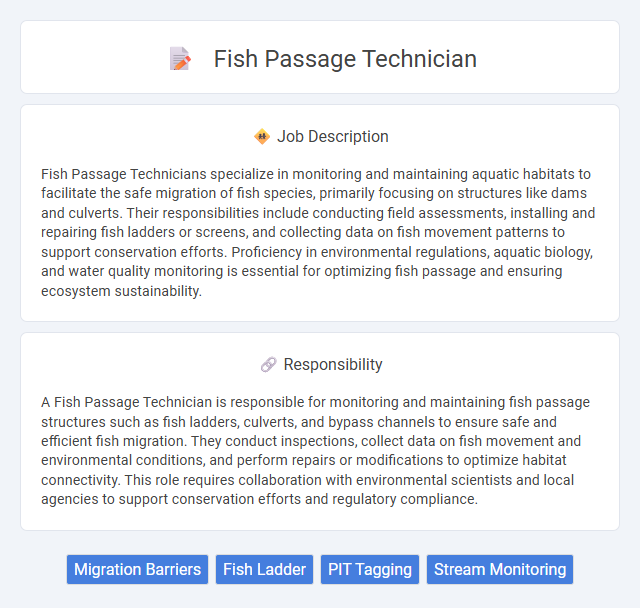
Fish Passage Technicians specialize in monitoring and maintaining aquatic habitats to facilitate the safe migration of fish species, primarily focusing on structures like dams and culverts. Their responsibilities include conducting field assessments, installing and repairing fish ladders or screens, and collecting data on fish movement patterns to support conservation efforts. Proficiency in environmental regulations, aquatic biology, and water quality monitoring is essential for optimizing fish passage and ensuring ecosystem sustainability.
Individuals with a strong physical condition and a keen interest in environmental conservation will likely find the Fish Passage Technician role suitable. Those comfortable working outdoors in various weather conditions and engaging in hands-on tasks involving fish habitat restoration might be particularly well-suited. Conversely, people who prefer sedentary or indoor work environments may find this job challenging to adapt to.
Qualification
Fish Passage Technicians require a strong background in biology, environmental science, or a related field, often supported by a bachelor's degree. Practical experience with fieldwork, fish monitoring techniques, and habitat restoration projects is essential. Proficiency in data collection, use of GPS and survey equipment, and knowledge of local aquatic ecosystems enhances job performance significantly.
Responsibility
A Fish Passage Technician is responsible for monitoring and maintaining fish passage structures such as fish ladders, culverts, and bypass channels to ensure safe and efficient fish migration. They conduct inspections, collect data on fish movement and environmental conditions, and perform repairs or modifications to optimize habitat connectivity. This role requires collaboration with environmental scientists and local agencies to support conservation efforts and regulatory compliance.
Benefit
Fish Passage Technicians likely play a crucial role in maintaining ecological balance by facilitating the safe migration of aquatic species. Their work probably supports conservation efforts, which can lead to improved biodiversity and healthier ecosystems. Employment in this field may offer benefits such as hands-on experience in environmental science, opportunities for outdoor work, and contributing meaningfully to natural resource management.
Challenge
Fish Passage Technicians are likely to face the challenge of navigating difficult terrain and variable weather conditions while installing and maintaining fish passage structures. Ensuring the effectiveness of barriers or culverts for fish migration may require precise monitoring and problem-solving skills. There is a strong probability that adapting to unexpected ecological or environmental obstacles will be a routine part of this role.
Career Advancement
Fish Passage Technicians play a crucial role in monitoring and maintaining aquatic ecosystems by ensuring safe fish migration routes. With experience, they can advance to roles such as Fishery Biologist, Environmental Consultant, or Project Manager, overseeing larger conservation projects and influencing environmental policy. Specialized skills in data analysis, habitat restoration, and regulatory compliance significantly enhance career growth opportunities in this field.
Key Terms
Migration Barriers
Fish Passage Technicians specialize in identifying and mitigating migration barriers such as dams, culverts, and weirs that obstruct fish movement in freshwater ecosystems. They conduct field assessments, collect data on fish behavior and habitat conditions, and implement solutions like fish ladders or barrier removals to restore natural migration routes. Their work supports fish population recovery, enhances biodiversity, and contributes to the health of aquatic ecosystems.
Fish Ladder
Fish Passage Technicians specialize in monitoring and maintaining fish ladders to ensure safe migration of aquatic species such as salmon and trout. They conduct regular inspections, perform repairs, and collect data on fish movement to optimize ladder efficiency and support conservation efforts. Their work contributes to sustaining biodiversity and promoting healthy ecosystems in riverine environments.
PIT Tagging
A Fish Passage Technician specializing in PIT tagging plays a critical role in monitoring fish movement and behavior by implanting Passive Integrated Transponder (PIT) tags in fish populations. This job requires precise handling and data recording to ensure accurate tracking of tagged fish, which aids in habitat restoration and conservation efforts. Expertise in using PIT tag readers and maintaining equipment is essential for collecting reliable data on fish passage and migration patterns.
Stream Monitoring
Fish Passage Technicians specialize in stream monitoring to assess fish migration patterns and habitat connectivity. They collect hydrological and biological data, using tools such as flow meters and GPS to evaluate stream conditions and identify barriers to fish movement. Their work supports the design and implementation of fish-friendly structures that enhance aquatic ecosystems and promote species conservation.
 kuljobs.com
kuljobs.com